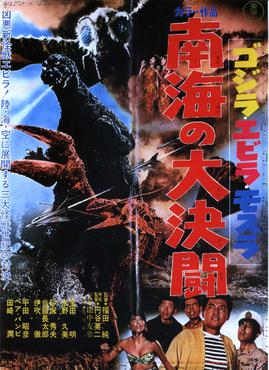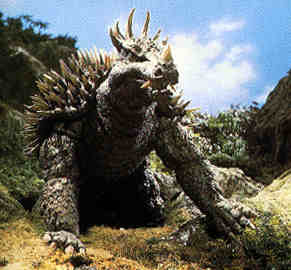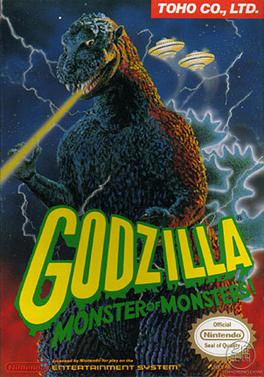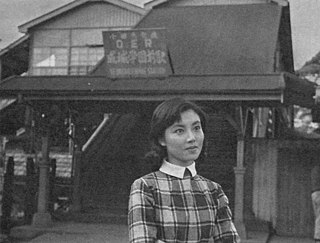Related Research Articles

Ebirah, Horror of the Deep is a 1966 Japanese kaiju film directed by Jun Fukuda and produced and distributed by Toho Co., Ltd. The film stars Akira Takarada, Kumi Mizuno, Akihiko Hirata and Eisei Amamoto, and features the fictional monster characters Godzilla, Mothra, and Ebirah. It is the seventh film in the Godzilla franchise, and features special effects by Sadamasa Arikawa, under the supervision of Eiji Tsuburaya. In the film, Godzilla and Ebirah are portrayed by Haruo Nakajima and Hiroshi Sekita, respectively.

Godzilla vs. Megalon is a 1973 Japanese kaiju film directed by Jun Fukuda, written by Fukuda and Shinichi Sekizawa, and produced by Tomoyuki Tanaka, with special effects by Teruyoshi Nakano. Distributed by Toho and produced under their effects subsidiary Toho–Eizo, it is the 13th film in the Godzilla franchise, and features the fictional monster characters Godzilla, Megalon, and Gigan, along with the mecha character Jet Jaguar. The film stars Katsuhiko Sasaki, Hiroyuki Kawase, Yutaka Hayashi, and Robert Dunham, alongside Shinji Takagi as Godzilla, Hideto Date as Megalon, Kenpachiro Satsuma as Gigan, and Tsugutoshi Komada as Jet Jaguar.

Anguirus is a fictional monster, or kaiju, which first appeared in Godzilla Raids Again (1955), the second film in the Godzilla franchise. Anguirus is the first monster to be shown engaging in combat with Godzilla in a film. Since then, the character has appeared conversely as an enemy and an ally of Godzilla in numerous films produced by Toho, including Destroy All Monsters, Godzilla vs. Gigan, Godzilla vs. Megalon, Godzilla vs. Mechagodzilla, and Godzilla: Final Wars. He has also appeared in other media, including comic books and video games.

Godzilla vs. Destoroyah is a 1995 Japanese kaiju film directed by Takao Okawara, with special effects by Kōichi Kawakita. Distributed by Toho and produced under their subsidiary Toho Pictures, it is the 22nd installment in the Godzilla franchise, and is the seventh and final film in the franchise's Heisei period. The film features the fictional monster characters Godzilla, Godzilla Junior and Destoroyah, and stars Takuro Tatsumi, Yōko Ishino, Yasufumi Hayashi, Sayaka Osawa, Megumi Odaka, Masahiro Takashima, Momoko Kōchi and Akira Nakao, with Kenpachiro Satsuma as Godzilla, Hurricane Ryu as Godzilla Junior, and Ryo Hariya as Destoroyah.

Godzilla: Monster of Monsters! (ゴジラ) is a Nintendo Entertainment System video game released in Japan in 1988 and in 1989 in the US by Toho Co., Ltd. The North American version removes all references to Toho Cenfile-Soft Library and Compile, crediting the game to Toho Eizo on the title screen instead.

Godzilla vs. SpaceGodzilla is a 1994 Japanese kaiju film directed by Kensho Yamashita, with special effects by Kōichi Kawakita. Distributed by Toho and produced under their subsidiary Toho Pictures, it is the 21st film in the Godzilla franchise, as well as the sixth film in the franchise's Heisei series. The film is notable for the introduction of the monster SpaceGodzilla, as well as the re-introduction of the mecha character M.O.G.U.E.R.A.; its first appearance on-screen since the 1957 film The Mysterians.

Hedorah, also known as the Smog Monster, is a kaiju monster who first appeared in Toho's 1971 film Godzilla vs. Hedorah. The huge monster was named for Hedoro (へどろ), the Japanese word for sludge, slime, vomit or chemical ooze.
Godzilla has appeared in a range of comic books that have been published in Japan and the United States.

Baragon is a fictional monster, or kaiju, which first appeared in Ishirō Honda's 1965 film Frankenstein vs. Baragon, produced and distributed by Toho. Depicted as a burrowing, four-legged, horned dinosaur-like creature with large ears, Baragon appeared alongside Godzilla and other monster characters in films in the Godzilla franchise, also produced by Toho, including Destroy All Monsters and Godzilla, Mothra and King Ghidorah: Giant Monsters All-Out Attack.

Godzilla Island is a television show spinoff of the Godzilla franchise. It premiered on October 6, 1997, and ran for a total of 256 three-minute episodes, finishing on September 30, 1998.

Godzilla is a Japanese monster, or kaiju, media franchise consisting of films, television series, novels, comic books, video games, and other merchandise. The franchise is centered on the fictional kaiju Godzilla, a prehistoric reptilian monster awakened and powered by nuclear radiation. The franchise is recognized by the Guinness World Records as the "longest continuously running film franchise", having been in ongoing production since 1954, with several hiatuses of varying lengths. The film franchise consists of 38 films: 33 Japanese films produced and distributed by Toho Co., Ltd.; and five American films, the first of which was produced by TriStar Pictures and the remaining four by Legendary Pictures, with the latest being released in March 2024.

Godzilla: Battle Legends, simply referred to as Godzilla in North America, is a fighting game based on the Godzilla film franchise, made for the Turbo Duo in 1993, developed by Alfa System and published in the United States by Hudson Soft.
G-Fest, often typeset as G-FEST, is an annual convention devoted to the Godzilla film franchise and other kaiju franchises such as Gamera and the Ultra Series. G-Fest is staged by Daikaiju Enterprises, Ltd., and G-Fan magazine. It regularly features panels, contests, and theatrically screened films of interest to fans of Japanese monsters.

Miki Saegusa is a recurring fictional character from the Heisei series of Godzilla films. She is a psychic who uses her powers to communicate with and, in some instances, control the mutant dinosaur Godzilla, and is credited for being the most frequently recurring human character in any kaiju series.
Godzilla is a series of novels written by author Marc Cerasini, based on the film series of the same name produced by Toho. While all set within the same continuity, each novel has its own plot and storyline, with Toho's kaiju featured as the stars.

Kaijū-ō Godzilla is a 1993 action adventure game by Bandai for the Game Boy. It was released exclusively in Japan. The game is notable for featuring nearly every monster in the Godzilla franchise up until the time of its release.

Kumi Mizuno is a Japanese actress best known for appearing in several Toho kaiju films of the 1960s and early 1970s.
Keizō Murase is a Japanese suitmaker, stuntman, sculptor, modeler, and film director. He is particularly well known for his work in giant monster films, including Mothra (1961), King Kong vs. Godzilla (1962), and The Mighty Peking Man (1977).
Toho International, Inc. is an American company that is a subsidiary of Japanese film company Toho Co., Ltd. Founded in May 1953, the company was initially created to sell films by Toho in North and South America; amongst their first features to export overseas were Seven Samurai and Godzilla. Toho International currently manages the licensing, marketing, and distribution of Toho's movies and other products and are headquartered in Los Angeles.
References
- ↑ "Godzilla: Save the Earth Monster Profile - Baragon - GameSpot". gamespot.com. Retrieved June 23, 2020.
- ↑ Howell, Peter (April 19, 2000). "Psycho killer is no pop culture anti-hero". Toronto Star . Toronto, Ontario, Canada: Toronto Star Newspapers Ltd. Archived from the original on August 6, 2018. Retrieved January 2, 2016.
- ↑ Guardian Unlimited; BRET EASTON ELLIS.
- ↑ Steffen Hantke (September 30, 2010). American Horror Film: The Genre at the Turn of the Millennium. Univ. Press of Mississippi. pp. 111–112. ISBN 978-1-60473-454-6.
- ↑ Halberstam, Judith (1995). "Skinflick: Posthuman Gender in Jonathan Demme's The Silence of the Lambs". Skin Shows: Gothic Horror and the Technology of Monsters. Duke University Press Books. ISBN 978-0-8223-1663-3.
- ↑ "100 Greatest Heroes and Villains - AFI". Filmsite.org. Retrieved August 29, 2011.
- ↑ Gallagher, Danny. "Dallas Actor Paul T. Taylor Sinks His Hooks Into the Role of Horror Film Villain Pinhead". Dallas Observer . Retrieved March 10, 2017.
- ↑ Webb, Charles. "'Child's Play' Killer Chucky The Unlikely Hero of Endless Runner 'Chucky: Slash & Dash'". MTV. Archived from the original on September 27, 2013.
- ↑ Iaccino, James F. (1998). "The Omen Trilogy: The Growth of the Demon Child Archetype". Jungian Reflections within the Cinema: A Psychological Analysis of Sci-Fi and Fantasy Archetypes. Praeger. pp. 147–165. ISBN 978-0-275-95048-4.
- ↑ Willis, J.; Monush, B. (2006). Screen World: 2005 Film Annual. Applause Books. Hal Leonard. p. 220. ISBN 978-1-55783-667-0 . Retrieved December 13, 2017.
- ↑ Brannon Braga and Ronald D. Moore (2003). "Freddy & Jason Go to Development Hell/Slicing Towards Production" Fangoria Magazine Articles in September/October 2003 issues (Freddy vs. Jason DVD Special Features) (DVD (Region 2)). United States: New Line Cinema.
- ↑ "Where in the Horror are they Now? The Cast of My Bloody Valentine (1981)!". JoBlo Movie Network. Retrieved August 7, 2016.
- ↑ AFI list of 100 heroes and villains
- ↑ 'Scream 2007 Awards Coming to Spike TV on 23 October'. Retrieved 11 October 2009.
- ↑ "Staff & Contributors « SciFi Japan". SciFi Japan. May 18, 1998. Retrieved January 22, 2014.